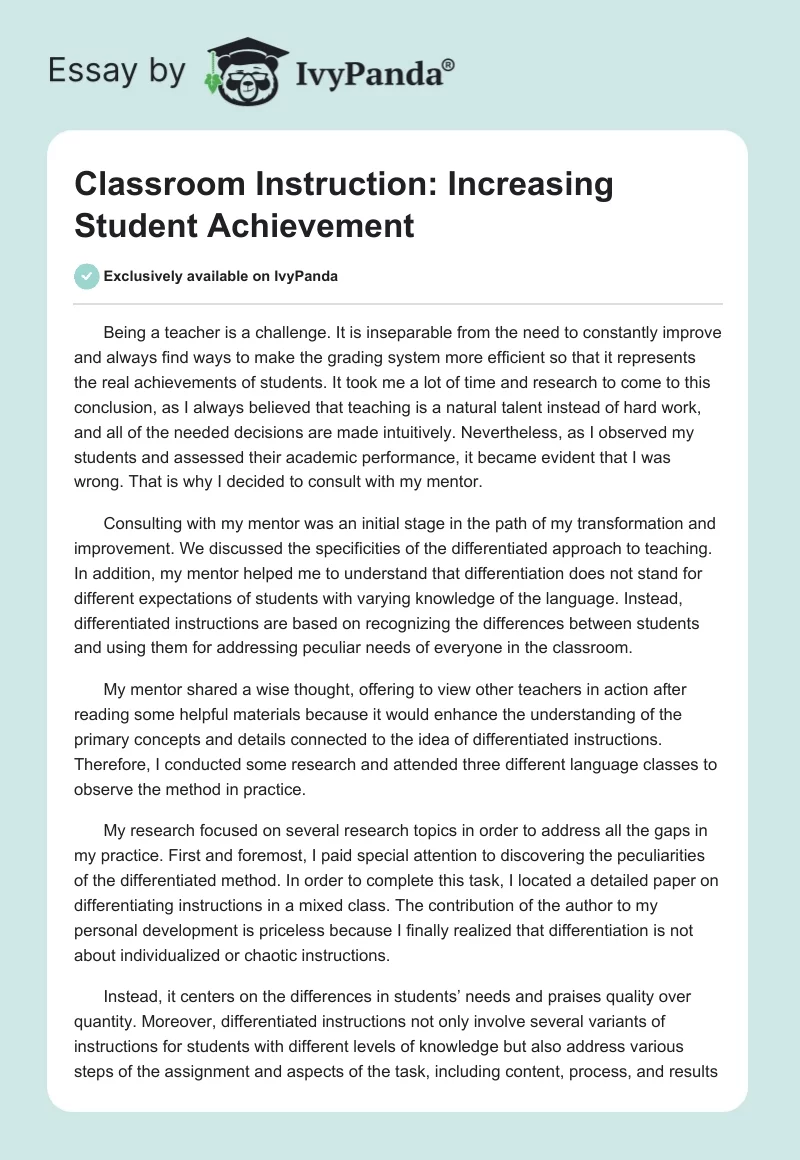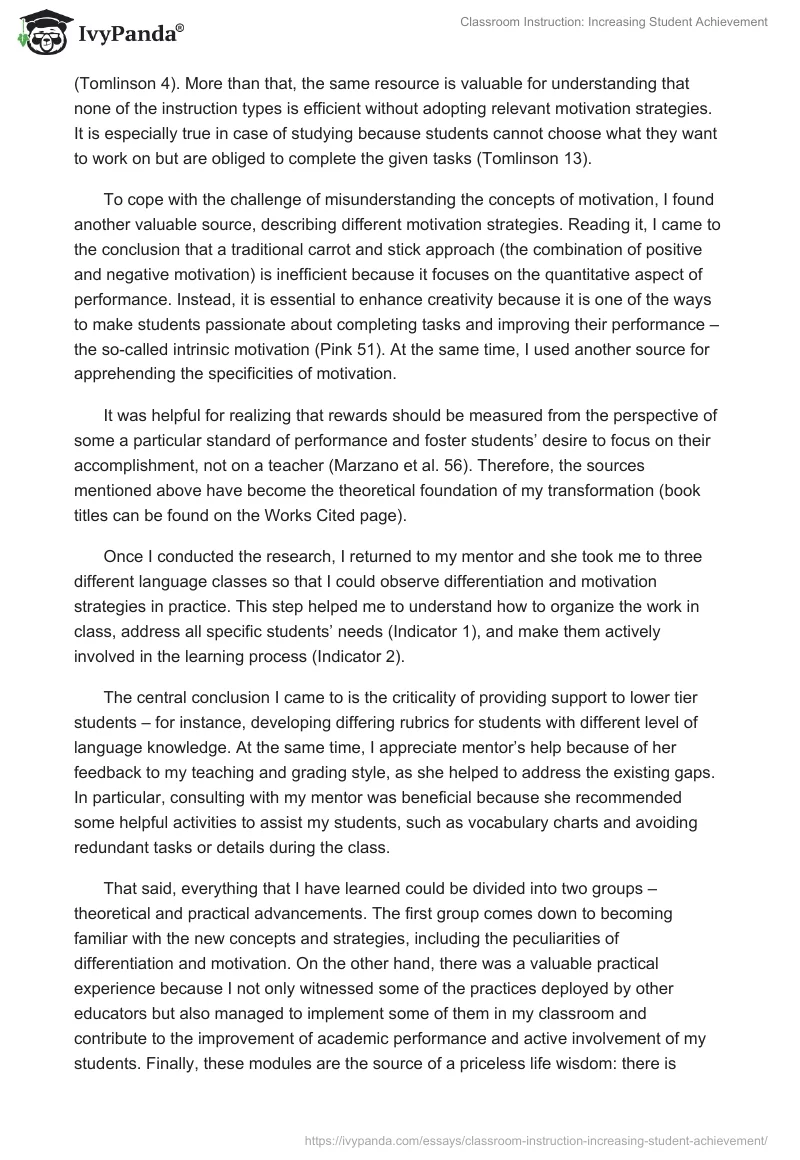Being a teacher is a challenge. It is inseparable from the need to constantly improve and always find ways to make the grading system more efficient so that it represents the real achievements of students. It took me a lot of time and research to come to this conclusion, as I always believed that teaching is a natural talent instead of hard work, and all of the needed decisions are made intuitively. Nevertheless, as I observed my students and assessed their academic performance, it became evident that I was wrong. That is why I decided to consult with my mentor.
Consulting with my mentor was an initial stage in the path of my transformation and improvement. We discussed the specificities of the differentiated approach to teaching. In addition, my mentor helped me to understand that differentiation does not stand for different expectations of students with varying knowledge of the language. Instead, differentiated instructions are based on recognizing the differences between students and using them for addressing peculiar needs of everyone in the classroom.
My mentor shared a wise thought, offering to view other teachers in action after reading some helpful materials because it would enhance the understanding of the primary concepts and details connected to the idea of differentiated instructions. Therefore, I conducted some research and attended three different language classes to observe the method in practice.
My research focused on several research topics in order to address all the gaps in my practice. First and foremost, I paid special attention to discovering the peculiarities of the differentiated method. In order to complete this task, I located a detailed paper on differentiating instructions in a mixed class. The contribution of the author to my personal development is priceless because I finally realized that differentiation is not about individualized or chaotic instructions.
Instead, it centers on the differences in students’ needs and praises quality over quantity. Moreover, differentiated instructions not only involve several variants of instructions for students with different levels of knowledge but also address various steps of the assignment and aspects of the task, including content, process, and results (Tomlinson 4). More than that, the same resource is valuable for understanding that none of the instruction types is efficient without adopting relevant motivation strategies. It is especially true in case of studying because students cannot choose what they want to work on but are obliged to complete the given tasks (Tomlinson 13).
To cope with the challenge of misunderstanding the concepts of motivation, I found another valuable source, describing different motivation strategies. Reading it, I came to the conclusion that a traditional carrot and stick approach (the combination of positive and negative motivation) is inefficient because it focuses on the quantitative aspect of performance. Instead, it is essential to enhance creativity because it is one of the ways to make students passionate about completing tasks and improving their performance – the so-called intrinsic motivation (Pink 51). At the same time, I used another source for apprehending the specificities of motivation.
It was helpful for realizing that rewards should be measured from the perspective of some a particular standard of performance and foster students’ desire to focus on their accomplishment, not on a teacher (Marzano et al. 56). Therefore, the sources mentioned above have become the theoretical foundation of my transformation (book titles can be found on the Works Cited page).
Once I conducted the research, I returned to my mentor and she took me to three different language classes so that I could observe differentiation and motivation strategies in practice. This step helped me to understand how to organize the work in class, address all specific students’ needs (Indicator 1), and make them actively involved in the learning process (Indicator 2).
The central conclusion I came to is the criticality of providing support to lower tier students – for instance, developing differing rubrics for students with different level of language knowledge. At the same time, I appreciate mentor’s help because of her feedback to my teaching and grading style, as she helped to address the existing gaps. In particular, consulting with my mentor was beneficial because she recommended some helpful activities to assist my students, such as vocabulary charts and avoiding redundant tasks or details during the class.
That said, everything that I have learned could be divided into two groups – theoretical and practical advancements. The first group comes down to becoming familiar with the new concepts and strategies, including the peculiarities of differentiation and motivation. On the other hand, there was a valuable practical experience because I not only witnessed some of the practices deployed by other educators but also managed to implement some of them in my classroom and contribute to the improvement of academic performance and active involvement of my students. Finally, these modules are the source of a priceless life wisdom: there is nothing disgraceful in asking for help and learning because life is a chain of constant changes and the path of improvement.
Except for new learning, the obtained knowledge and experience have a direct influence on my teaching practice as well as students. To begin with, I implemented several new techniques for arranging learning in my classroom. This decision was made based on both mentor recommendations and research findings. For instance, I designed vocabulary charts, provided more support and help to standard students, gave personal feedback, and developed differentiated rubrics for estimating the performance of standard and honor students. These changes had both personal and practical impact on the perception of my teaching.
First of all, they pointed to the fact that I was interested in personal development and self-improvement. It made me feel satisfied with the chosen attitude to both life and teaching. At the same time, this experience was beneficial for understanding that my knowledge was limited and motivated me to keep on working and studying.
As for the influence of my teaching, it was as well spectacular. To begin with, it seems different. It is not only the personal perception but also the flow of work that make it new. As for now, teaching is easier because I can see that the pressure on both students and me has decreased. More than that, I do not feel stressed because I have clear instructions for estimating students’ performance. From this perspective, I believe that this learning and practical experience made me a better and more efficient teacher able to share knowledge with my students and helping them to improve their skills in the Chinese language.
On the other hand, the implementation of new teaching techniques influenced my students. The changes in them are evident, as they expressed their gratitude for upgrading the system and introducing vocabulary charts. From this perspective, communicating with my students after the class and collecting their oral feedback is one of the ways to know about the effect of changes on them. Moreover, it is easy to note that they appreciate support and help because using pinyin in cards and instructions for standard students is beneficial for memorizing characters. At the same time, typing instructions for honor students in Chinese characters challenges them and tests their knowledge, thus keeping them motivated to improve.
Another way to measure the influence of new strategies on students is asking them to fill checklists aimed at assessing the innovations. The idea is to collect feedback from all students, not only those willing to express their opinion in words after the class. Except for collecting feedback, assessing performance is another helpful way to determine the influence of changes on students. It is even more efficient because it may demonstrate whether the implementations helped to achieve improvement in learning outcomes. Therefore, collecting both feedback and pre/post data is helpful for measuring the effect of changes on students.
Finally, it is critical to state that the new teaching style should be reviewed and altered on a timely basis. For instance, instructions should be changed in order to keep students motivated. In this way, avoiding pinyin when standard students progress in their knowledge or adding new and more complicated characters to honor students’ instructions would be beneficial for making them feel driven to gain new knowledge. The rationale for this statement is the fact that I noticed that somehow both groups of students tend to pay less time to instructions when they are similar that leads to misunderstanding tasks and completing them partially. Therefore, this step is essential.
Works Cited
Marzano, Robert. J., et al. Classroom Instruction That Works: Research-Based Strategies for Increasing Student Achievement. ASCD, 2005.
Pink, Daniel H. Drive: The Surprising Truth About What Motivates Us. Riverhead Books, 2009.
Tomlinson, Carol Ann. How to Differentiate Instruction in Mixed-Ability Classroom. ASCD, 2001.


